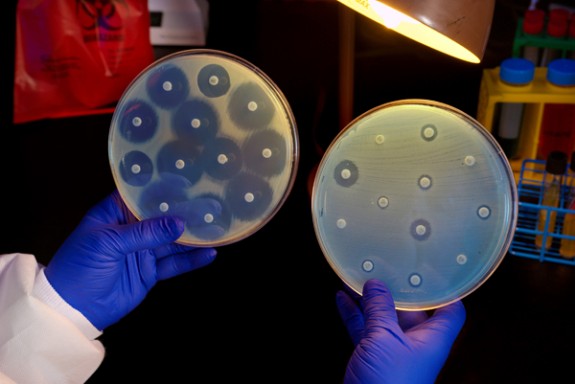This is Bad: ‘Nightmare Bacteria’ Are More Common Than We Thought
“Nightmare bacteria” are here, and they’re more common than we thought

Little pucks of antibiotics are placed in petri dishes filled with bacteria. In the dish on the left the bacteria can’t grow near the antibiotics. In the right petri dish, antibiotic resistant bacteria don’t mind the antibiotic pucks. Photo: CDC
Back in March of this year the Centers for Disease Control and Prevention warned us that we are presently facing down a scourge of “nightmare bacteria.”
The CDC doesn’t use the word “nightmare” lightly. These bacteria really are scary, as CDC director Dr. Tom Frieden said:
They pose a triple threat. First, they’re resistant to all or nearly all antibiotics. Even some of our last-resort drugs. Second, they have high mortality rates. They kill up to half of people who get serious infections with them. And third, they can spread their resistance to other bacteria.
Maryn McKenna, a journalist who keeps a close watch on all things infectious disease, points today to some new research that found that nightmare-level antibiotic resistance is even more common than we thought. In an upcoming report, scientists note that the so-called nightmare strains are roughly twice as good at fighting off antibiotics as the CDC thinks.
Antibiotic-resistant bacteria, like the more well-known MRSA (methicillin-resistant staphylococcus aureus), are able to fight off some of our antibiotics. But “nightmare” bacteria can fight off almost all of them. These germs are otherwise the same, but without our best defenses, infections that would otherwise be easily cured are now more likely to be deadly.
Scientists have actually known about the nightmare bacteria for a long time. They first popped up (that we know of) in a North Carolina hospital in 1996, says McKenna. But the global health monitoring system designed to root out antibiotic resistance wasn’t big enough, and the bugs spread unchecked. A series of further outbreaks around the world followed, and now here we are—facing a foe that bypasses nearly all of our defenses.
Worse still, “the rapid advance of resistance and the consequent need to use these drugs sparingly has convinced pharmaceutical companies that antibiotics are not worth the investment,” says McKenna. So while antibiotic resistance is booming, we have fewer new types of drugs in the works than before.
Quoting from the report that highlighted the expanded resistance of nightmare bacteria, McKenna says:
“Pharmaceutical companies have voted with their feet. Twenty years ago, more than twenty large companies had active discovery and development programs for antibacterial agents; in 2013, only four have active discovery programs. Our approval rate for new antibiotics has fallen to dismally low levels.”
More from Smithsonian.com:
You Should Be Really Scared of the CDC’s ‘Nightmare Bacteria’
/https://tf-cmsv2-smithsonianmag-media.s3.amazonaws.com/accounts/headshot/smartnews-colin-schultz-240.jpg)
/https://tf-cmsv2-smithsonianmag-media.s3.amazonaws.com/accounts/headshot/smartnews-colin-schultz-240.jpg)